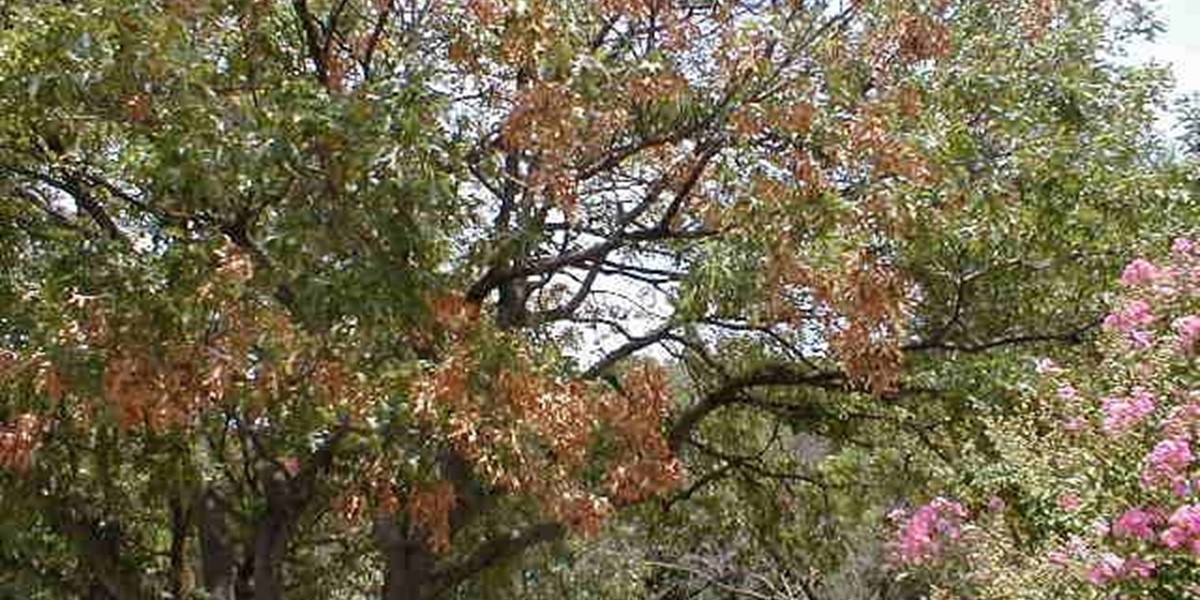
Published January 18, 2006 By RUSSELL PETERS
Our clients often hear different, confusing, or contradictory statements regarding the risks related to the pruning of Oak trees during the spring. Today’s wealth of information venues often contributes to the confusion. Why are there concerns about risks associated with pruning Oak trees in the spring? Let’s examine two facts and work toward a simple conclusion that should be helpful.
- The physical act of properly pruning an Oak tree in the spring has no negative effect, physiologically or otherwise, on the overall health and vigor of an Oak tree.
- A tree, Oak or otherwise, is more susceptible to invasion by pests and diseases during the spring flush or reproductive cycle.
At anytime of the year, with a conservative approach to pruning and specific objectives applied, there is no negative effect on a tree’s overall health and vigor to any species of tree. However, over-pruning, the removal of excessive amounts of foliage (greater than 20%) at anytime of the year, will cause a decrease in a tree’s ability to carry on its life-long mission of photosynthesis. The simple reduction in photosynthetic leaf area results in a decrease of available energy for the many activities a tree must execute. This includes defense against invasion by damaging organisms.
Flowering, and the production of new foliage require an enormous amount of energy. The fluctuation in a tree’s year-round energy reserves is lowest immediately after the completion of its reproductive cycle. Thus, the amount of energy available to use for defense against invasion by pathogens is at its lowest point. Once the expansion of new leaves occurs, the ability of a tree to carry on photosynthesis begins for the upcoming season.
Why are we cautioned to "avoid" wounding or pruning Oak species in the spring? The reasons you hear this warning are: 1) the tree’s energy levels are low, as previously explained; and 2) a major vascular pathogen, the Oak Wilt fungus, has the ability to initiate a portion of its reproductive cycle in the spring and the pathogen can be carried from tree to tree by a specific sap-feeding beetle.
These insects are attracted to fresh wounds of any tree species. They like the smell of new wounds on trees as well as the smell of the Oak Wilt fungus reproductive structure. The wounds created by pruning at anytime of the year are just as attractive, but the numbers of sap-feeding beetles diminish dramatically AND the ability of the fungus to initiate its reproductive cycle ceases as temperatures rise.
The Arborists and Staff at Arborilogical Services, along with Dr. David Appel at Texas A&M University, have attempted to properly provide the public with a consistent pruning avoidance period applicable throughout Texas. It is a tall order often defeated by misinformation that still occurs to this day. Case in point: The recent issue of a suburban city’s neighborhood newsletter includes an article that states the pruning avoidance period as “February through September”. This is incorrect and only makes the issue more confusing. We have contacted the city and they will issue a correction statement.
So, when is the time to avoid pruning or wounding Oak trees? Okay, here it is: Spring! However, pruning Oaks during this time IS safe if the wounds two inches in diameter and larger have a thin coat of wound dressing applied to them as the cuts are made.
We define spring as the time when trees become active—after winter dormancy, and during flowering and re-leafing. This period can vary dramatically in north Texas. Depending on when temperatures rise steadily, the average time begins in mid-February. We see this happening when we enjoy the essence of spring. The avoidance period (or time to take extra precautions) ends when temperatures consistently rise to 90 degrees and above, which usually corresponds with the end of May. See how confusing this explanation becomes! Our conclusion to defining when the two events occur can be more simply described by stating the period of time as Valentine’s Day, February 14th, through Memorial Day, or the last day of May.
Hopefully, this resolves some of the confusion surrounding the pruning of Oaks. Please feel free to contact your consulting arborist by email or phone, 972-442-1524; and they will be glad to further discuss the matter and answer any additional questions you might have.
